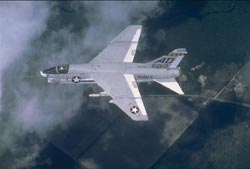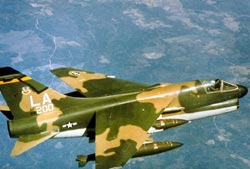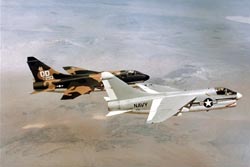|
 A part of the original VA(L) RFP called for consideration of an advanced avionics concept designated as the Integrated Light Attack Avionics Suite 1965 (ILAAS 65). This was a concept being developed by the Sperry Corporation under a U.S. Navy Research & Development contract and intended for incorporation in A-7's when the LTV airframe had sufficiently matured and the avionics suite was in a satisfactory state of development. The A-7E was intended to be the recipient of this fine new system, but there was a long road to travel before the avionics suite would be available. Entry of the U. S. Air Force into the procurement process introduced further delays. A part of the original VA(L) RFP called for consideration of an advanced avionics concept designated as the Integrated Light Attack Avionics Suite 1965 (ILAAS 65). This was a concept being developed by the Sperry Corporation under a U.S. Navy Research & Development contract and intended for incorporation in A-7's when the LTV airframe had sufficiently matured and the avionics suite was in a satisfactory state of development. The A-7E was intended to be the recipient of this fine new system, but there was a long road to travel before the avionics suite would be available. Entry of the U. S. Air Force into the procurement process introduced further delays.
 While Vought and the Navy were launching the A-7E configuration studies, DOD was lobbying Congress for funds to buy a version of the A-7 for the Air Force. This was based on studies which indicated that a single-purpose attack aircraft would be many times more cost-effective than trying to satisfy the Vietnam ground war close support requirements with high-performance fighters equipped to drop bombs. Congress approved the funds in 1966 and the program was underway. As the Air Force defined its requirements, it soon became obvious that the 20-plus changes they defined would create a new model of the aircraft, and the A-7D designation was assigned. The program was to be managed out of the U.S. Navy Program Office in Washington D..C. and was headed by a crusty and crafty old fighter pilot of World War II fame, Thomas (Black Tom) Gallagher. His Deputies were Navy Captain Bob Doss and Air Force Colonel Bob Hails. Bob Doss was a true visionary with great skills in the field of avionics. Captain Doss deserves the lion's share of the credit for the success of the avionics suite used in the A-7D and A-7E airplanes. Bob Hails led the A-7D development through a veritable minefield of technical and political considerations. While Vought and the Navy were launching the A-7E configuration studies, DOD was lobbying Congress for funds to buy a version of the A-7 for the Air Force. This was based on studies which indicated that a single-purpose attack aircraft would be many times more cost-effective than trying to satisfy the Vietnam ground war close support requirements with high-performance fighters equipped to drop bombs. Congress approved the funds in 1966 and the program was underway. As the Air Force defined its requirements, it soon became obvious that the 20-plus changes they defined would create a new model of the aircraft, and the A-7D designation was assigned. The program was to be managed out of the U.S. Navy Program Office in Washington D..C. and was headed by a crusty and crafty old fighter pilot of World War II fame, Thomas (Black Tom) Gallagher. His Deputies were Navy Captain Bob Doss and Air Force Colonel Bob Hails. Bob Doss was a true visionary with great skills in the field of avionics. Captain Doss deserves the lion's share of the credit for the success of the avionics suite used in the A-7D and A-7E airplanes. Bob Hails led the A-7D development through a veritable minefield of technical and political considerations.
Given that DoD, not the Air Force, selected the A-7, Colonel Hails had a very difficult task in keeping his Air Force bosses happy, while maintaining the program on an even keel. With Sol Love leading the company team, it was indeed a powerful triumvirate.
Hallmark of this A-7 series was the incorporation of a state-of-the-art Navigation/Weapon Delivery system built around the ASN-91 Central Computer. Major systems elements included the APQ-126 Radar, AVQ-7 Head-Up Display, and a Projected Map Display system. There were also major improvements in the Doppler Radar, Inertial Navigation System, and Weapon Control System.
 The other major change was in the propulsion system. More thrust was desired by both services but the TF-30 engine had reached its limit of development without thrust augmentation, and an afterburning version was at least three years down the road. An ideal replacement candidate was the Rolls Royce Spey commercial engine. Rolls Royce teamed with Allison and bid a military version of the Spey. It became the TF-41 and filled the bill. The USAF TF-41-A1 version supplied 14,250 pounds of thrust, and the Navy's TF-41-A-2 model produced 15,000 pounds. The other major change was in the propulsion system. More thrust was desired by both services but the TF-30 engine had reached its limit of development without thrust augmentation, and an afterburning version was at least three years down the road. An ideal replacement candidate was the Rolls Royce Spey commercial engine. Rolls Royce teamed with Allison and bid a military version of the Spey. It became the TF-41 and filled the bill. The USAF TF-41-A1 version supplied 14,250 pounds of thrust, and the Navy's TF-41-A-2 model produced 15,000 pounds.
There were other significant changes that the Air Force required, some of which were picked up by the Navy in the A-7E version. The M-61 "Gatling Gun", with its incredible rate of fire, was one of the changes picked up by the Navy.
Peculiar to the Air Force A-7D were the band receptacle type of inflight refueling system, higher energy-rated wheels, tires, and brakes, and the ESCAPAC IC ejection seat, modified to utilize the USAF survival kit and restraint system together with a low-pressure, demand-type oxygen system.
Both the A7-D and the A-7E aircraft went on to establish an impressive string of combat successes in Vietnam.
A-7:
Genesis of the Navy Attack Bomber, Light (VA(L))
In Comat
Farewell Proud Bird
Aircraft Performance Perspective
Low Altitude Night Attack (LANA)
A-7E Maintance Guarantee
|